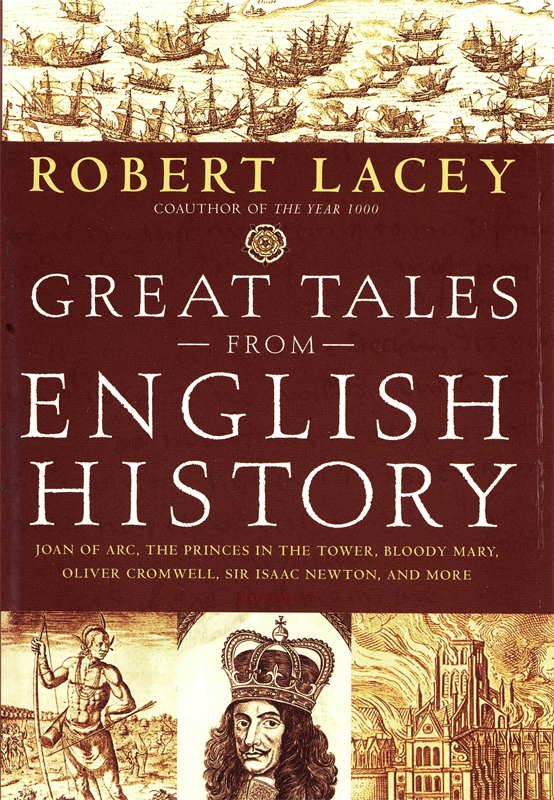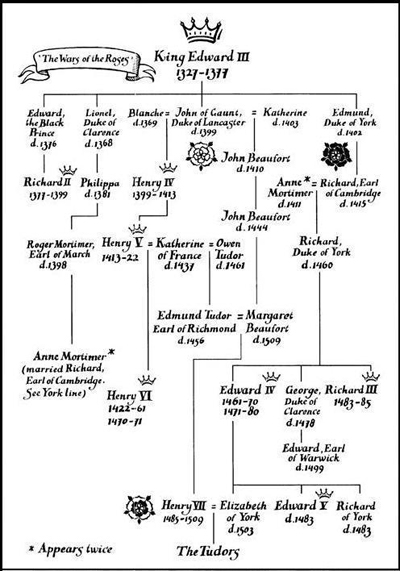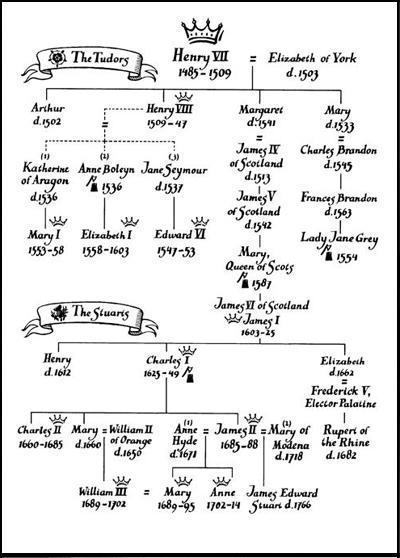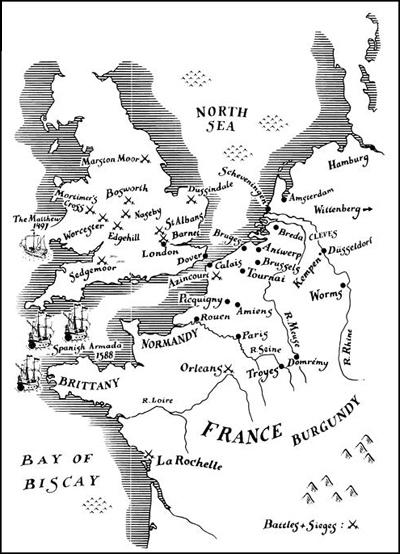Great Tales from English History, Book 2
Read Great Tales from English History, Book 2 Online
Authors: Robert Lacey


ROBERT
,
EARL OF ESSEX
THE LIFE AND TIMES OF HENRY VIII
THE QUEENS OF THE NORTH ATLANTIC
SIR WALTER RALEGH
MAJESTY
:
ELIZABETH II AND THE HOUSE OF WINDSOR
THE KINGDOM
PRINCESS
ARISTOCRATS
FORD
:
THE MEN AND THE MACHINE
GOD BLESS HER
!
LITTLE MAN
GRACE
SOTHEBY
’
S
:
BIDDING FOR CLASS
THE YEAR
1000
THE QUEEN MOTHER’S CENTURY
ROYAL:
HER MAJESTY QUEEN ELIZABETH II
GREAT TALES FROM ENGLISH HISTORY
:
THE TRUTH ABOUT KING ARTHUR
,
LADY GODIVA
,
RICHARD THE LIONHEART, AND MORE
Copyright © 2004 by Robert Lacey
Illustrations and maps © 2004 by Fred van Deelen
All rights reserved. No part of this book may be reproduced in any form or by any electronic or mechanical means, including
information storage and retrieval systems, without permission in writing from the publisher, except by a reviewer who may
quote brief passages in a review.
Warner Books, Inc.
Hachette Book Group
237 Park Avenue
New York, NY 10017
Visit our website at
www.HachetteBookGroup.com
First published in Great Britain by Little, Brown and Company, 2004 First United States edition, June 2005
First eBook Edition: November 2009
ISBN: 978-0-316-09039-1
FOR SCARLETT
Contents
The Houses of York, Lancaster and Tudor
The Houses of Tudor and Stuart
Map of England and North-west Europe 1387-1688
Introduction: History in Our Heads
1387: Geoffrey Chaucer and the Mother Tongue
1599: The Deposing of King Richard II
1399: ‘Turn Again, Dick Whittington!’
1399: Henry IV and His Extra-Virgin Oil
1415: We Happy Few - the Battle of Azincourt
1429: Joan of Arc, the Maid of Orleans
1440: A‘Prompter for Little Ones’
1422-61, 1470-1: House of Lancaster: the Two Reigns of Henry VI
1432-85: The House of Theodore
1461-70, 1471-83: House of York: Edward IV, Merchant King
1483: Whodunit? The Princes in the Tower
1485: The Battle of Bosworth Field
1509-33: King Henry VIII’s Great Matter’
1525: Let There be Light’ William Tyndale and the English Bible
1535: Thomas More and His Wonderful‘No-Place’
1533-7: Divorced, Beheaded, Died…
1539-47:… Divorced, Beheaded, Survived
1547-53: Boy King - Edward VI, The Godly Imp’
1553: Lady Jane Grey -The Nine-Day Queen
1553-S: Bloody Mary and the Fires of Smithfield
1557: Robert Recorde and His Intelligence Sharpener
1559: Elizabeth - Queen of Hearts
1585: Sir Walter Ralegh and the Lost Colony
1588: Sir Francis Drake and the Spanish Armada
1605: 5/11: England’s First Terrorist
1611: King James’s‘Authentical’ Bible
1616: ’Spoilt Child’ and the Pilgrim Fathers
1622: The Ark of the John Tradescants
1629: God’s Lieutenant in Earth
1642: ’All My Birds Have Flown’
1642-8: Roundheads V. Cavaliers
1649: Behold the Head of a Traitor!
1653: ’Take Away This Bauble!’
1655: Rabbi Manasseh and the Return of the Jews
1660: Charles II and the Royal Oak
1665: The Village that Chose to Die
1678/9: Titus Oates and the Popish Plot
1685: Monmouth’s Rebellion and the Bloody Assizes
1687: Isaac Newton and the Principles of the Universe
Acclaim for Volume 1 of Robert Layer’s GREAT TALES FROM ENGLISH HISTORY

(see map on
page xii
for battles)



HISTORY IN OUR HEADS
F
OR MOST OF US, THE HISTORY IN OUR HEADS
is a colourful and chaotic kaleidoscope of images — Sir Walter Ralegh laying down
his cloak in the puddle, Isaac Newton watching the apple fall, Geoffrey Chaucer setting off for Canterbury with his fellow
pilgrims in the dappled medieval sunshine. We are not always sure if the stories embodied by these images are entirely true
— or if, in some cases, they are true at all. But they contain a truth, and their narrative power is the secret of their survival
over the centuries. You will find these images in the pages that follow — just as colourful as you remember, I hope, but also
closer to the available facts, with the connections between them just a little less chaotic.
Our very first historians were storytellers — our best historians still are — and in many languages‘story’ and‘history’ remain
the same word. Our brains are wired to make sense of the world through narrative — what came first and what came next — and
once we know the sequence, we can start to work out the how and why. We peer down the kaleidoscope in order to enjoy the sparkling
fragments, but as we
turn it we also look for the reassuring discipline of pattern. We seek to make sense of the scanty remnants of the lives that
preceded ours on the planet.
The lessons we derive from history inevitably resonate with our own code of values. When we go back to the past in search
of heroes and heroines, we are looking for personalities to inspire and comfort us, to confirm our view of how things should
be. That is why every generation needs to rewrite its history, and if you are a cynic you may conclude that a nation’s history
is simply its own deluded and self-serving view of its past.
Great Tales from English History
is not cynical: it is written by an eternal optimist — albeit one who views the evidence with a sceptical eye. In these books
I have endeavoured to do more than just retell the old stories; I have tried to test the accuracy of each tale against the
latest research and historical thinking, and to set them in a sequence from which meaning can emerge.
The first volume of
Great Tales from English History
showed how the beginnings of English history were shaped and reshaped by invasion — Roman, Anglo-Saxon, Danish, Norman. And
that was just the armies. The Venerable Bede, our first English historian, described the invasion of the new religion, which,
in AD 597, so scared King Ethelbert of Kent that he insisted on meeting the Christian missionaries out of doors, lest he be
trapped by their alien magic. We met Richard the Lionheart, England’s French-speaking hero-king, who spent only six months
living in England and adopted our Turkish-born patron saint, St George, while he was fighting the Crusades. Then, as now,
we discovered,
some of the things that most define England have come from abroad. Magna Carta was written in Latin, and Parliament, our national‘talking-place’,
derives its name from the French.
This volume opens in the aftermath of another invasion — by a black rat with an infected flea upon its back. In 1348 and in
a succession of subsequent outbreaks, the Black Death wiped out nearly half of England’s five million people. Could a society
undergo a more ghastly trauma? Yet there were dividends from that disaster: a smaller workforce meant higher wages; fewer
purchasers per acre brought property prices down. In 1381 the leaders of the so-called’Peasants’ Revolt’ with which we concluded
the earlier volume were men of a certain substance. They were taxpayers, the solid, middling folk who have been the backbone
of all the profound revolutions of history. Later in this volume we will see their descendants enlisting in an army that would
behead a king.
Changing economic circumstances have a way of shaping beliefs, and so it was in the fourteenth century. John Wycliffe told
the survivors of plague-stricken England that they should seek a more direct relationship with their God, read His word in
their own language, and not rely upon the priest. Wycliffe’s persecuted followers, the Lollards, or‘mumblers’, as they were
called by their detractors, in derision of their privately mouthed prayers, would provide a persistent underground presence
in the century and a half that followed. If invasion was the theme of the previous volume, dissent — spiritual, personal and,
in due course, political — will take centre stage in the pages that follow.